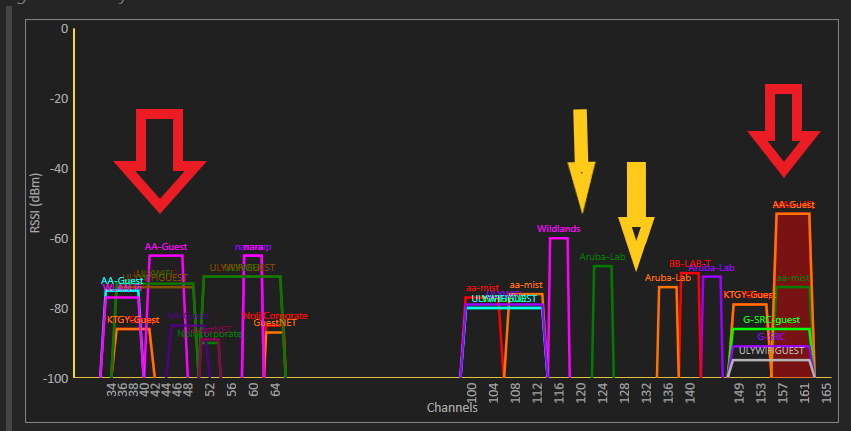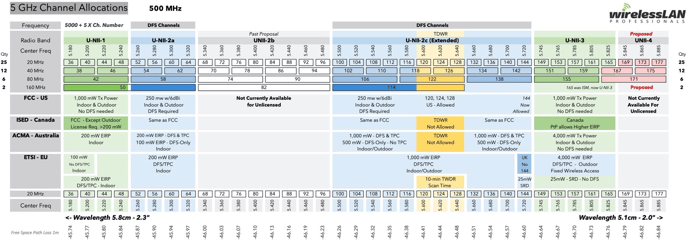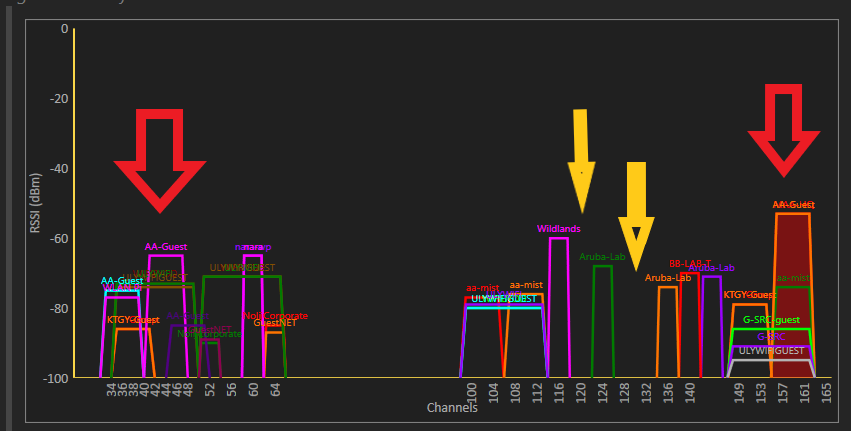Understanding 5 GHz channel history is key to making a better 5 GHz channel plan.
So, WiFi Scanner does a great job of illustrating the 5 GHz channel spectrum in real-time. Knowing what's around you and what networks are on what channel becomes priceless information to have when choosing your 5 GHz channel. But as you probably know the history of 5 GHz has and is ever-evolving to new heights.
As you look at WiFi Scanner there might be spots of the 5 GHz spectrum that seem open and obvious channel spots to pick. Looking at this picture of a Spectrum graph from my office can you see the obvious open channel located under the yellow arrows?

Now, these channels that the yellow arrows are over would be an ideal pick for a channel plan.
But have you wondered why are so many networks instead crowded toward the ends of the spectrum located under the red arrows? Well to simply answer the question it is complicated.
Let's start with the history of 5 GHz and where it came from. Now, unlike the older and more common 2.4Ghz WiFi spectrum that's largely unregulated by the FCC while 5 GHz is regulated by the FCC. That's why the popularity in the 2.4GHz spectrum grew much faster than 5 GHz.
2.4GHz has 13 channels with 3 non-overlapping 1,6, and 11. While 5 GHz today now has 25 non-overlapping channels to pick from but that wasn't always true. 5 GHz is split up into unique bands that have channels within them. These bands are referred to as UNII-1, UNII2, UNII2e, and UNII3. At first, the regulation only allowed 5 GHz networks to use the UNII-1 band which only provided 4 channels. Over time though regulation has changed and allowed UNII3 channels than UNII2 channels and now finally the UNII-2e(extended) channels which is what has lead to the recent boom in 5 GHz availability.
So what changed to let regulation make this happen? Well, one is advances in hardware capabilities.
Before the UNII2 channel was not available for commercial uses but has hardware improved this new technology called Dynamic Frequency Selection (DFS) emerged.
DFS is a WiFi function that enables WLANs to use 5 GHz frequencies that are generally reserved for radars. One main benefit of using DFS channels is to utilize under-serviced frequencies to increase the number of available WiFi channels
Another part of the 5 GHz spectrum was strictly used for what's called Terminal Doppler Weather Radar (TDWR). This is a Doppler weather radar system used primarily for the detection of hazardous wind shear conditions, precipitation, and winds near major airports situated in the United States. TDWR uses the frequency band from 5600-5650 MHz which directly lies in channels 120,124, 128, and their adjacents respectively.
When DFS detects any radar in the UNII-2 or UNII-2e channels they have to switch to a different channel and wait 10 minutes to come back onto that channel. This can lead to slowdowns if you have a high event probability.
Let's look at the official allocation chart for 5 GHz channels. I want you to notice the green UNII-1 and UNII-3 bands. Then above that is a grey ribbon that says "DFS Channels". Now you know what DFS is and why UNII-2 and UNII2e are in this range. Then lastly, notice the yellow strike down the "UNII-2(extended)" channels. That indicated the TDWR channels that have only recently been made legally available to the public for those that have DFS hardware capabilities on their AP.

Finally, let's look at the spectrum graph picture again of my office building. Looking at it a second time now do you realize anything that you didn't before?

Maybe now that you have read this it shines a little clarity on the challenges of 5 GHz channel planning and why your area might look like this when using WiFi Scanner. If you have a modern AP with DFS enable then there is no problem with using UNII2 channels. But if you wish to bond channels together for the higher throughput you might want to stick to non-DFS channels and especially do not use any of the TDWR channels that are prone to radar interference.
